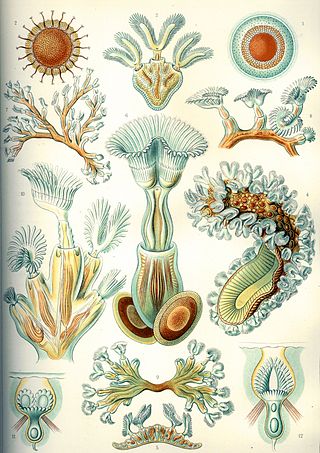
Bryozoa are a phylum of simple, aquatic invertebrate animals, nearly all living in sedentary colonies. Typically about 0.5 millimetres long, they have a special feeding structure called a lophophore, a "crown" of tentacles used for filter feeding. Most marine bryozoans live in tropical waters, but a few are found in oceanic trenches and polar waters. The bryozoans are classified as the marine bryozoans (Stenolaemata), freshwater bryozoans (Phylactolaemata), and mostly-marine bryozoans (Gymnolaemata), a few members of which prefer brackish water. 5,869 living species are known. Originally all of the crown group Bryozoa were colonial, but as an adaptation to a mesopsammal life or to deep-sea habitats, secondarily solitary forms have since evolved. Solitary species has been described in four genera; Aethozooides, Aethozoon, Franzenella and Monobryozoon). The latter having a statocyst-like organ with a supposed excretory function.

A tunicate is an exclusively marine invertebrate animal, a member of the subphylum Tunicata. This grouping is part of the Chordata, a phylum which includes all animals with dorsal nerve cords and notochords. The subphylum was at one time called Urochordata, and the term urochordates is still sometimes used for these animals. They are the only chordates that have lost their myomeric segmentation, with the possible exception of the seriation of the gill slits. However, doliolids still display segmentation of the muscle bands.

Thaliacea is a class of marine chordates within the subphylum Tunicata, comprising the salps, pyrosomes and doliolids. Unlike their benthic relatives the ascidians, from which they are believed to have emerged, thaliaceans are free-floating (pelagic) for their entire lifespan. The group includes species with complex life cycles, with both solitary and colonial forms.

Larvaceans or appendicularians, class Appendicularia, are solitary, free-swimming tunicates found throughout the world's oceans. While larvaceans are filter feeders like most other tunicates, they keep their tadpole-like shape as adults, with the notochord running through the tail. They can be found in the pelagic zone, specifically in the photic zone, or sometimes deeper. They are transparent planktonic animals, usually ranging from 2 mm (0.079 in) to 8 mm (0.31 in) in body length including the tail, although giant larvaceans can reach up to 10 cm (3.9 in) in length.

Ascidiacea, commonly known as the ascidians or sea squirts, is a paraphyletic class in the subphylum Tunicata of sac-like marine invertebrate filter feeders. Ascidians are characterized by a tough outer "tunic" made of a polysaccharide.
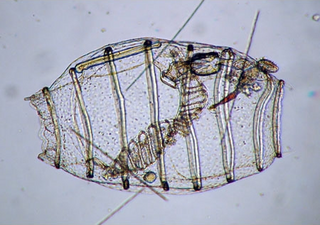
The Doliolida are an order of small marine chordates of the subphylum Tunicata. They are in the class Thaliacea, which also includes the salps and pyrosomes. The doliolid body is small, typically 1–2 mm long, and barrel-shaped; it features two wide siphons, one at the front and the other at the back end, and eight or nine circular muscle strands reminiscent of barrel bands.

A salp or salpa is a barrel-shaped, planktonic tunicate in the family Salpidae. It moves by contracting, thereby pumping water through its gelatinous body; it is one of the most efficient examples of jet propulsion in the animal kingdom. The salp strains the pumped water through its internal feeding filters, feeding on phytoplankton.

Pyrosomes are free-floating colonial tunicates in family Pyrosomatidae. There are three genera, Pyrosoma, Pyrosomella and Pyrostremma, and eight species. They usually live in the upper layers of the open ocean in warm seas, although some may be found at greater depths.

Botrylloides leachii is a colonial tunicate of the family Styelidae. Its unique methods of propagation and regeneration make it an ideal model organism for use in biological study of development, immunology, stem cells, and regeneration.

Pyrosoma atlanticum is a pelagic species of marine colonial tunicate in the class Thaliacea found in temperate waters worldwide. The name of the genus comes from the Greek words pyros meaning 'fire' and soma meaning 'body', referring to the bright bioluminescence sometimes emitted. The specific epithet atlanticum refers to the Atlantic Ocean, from where the first specimen of the species was collected for scientific description; it was described in 1804 by François Péron, a French naturalist.
Cyclosalpa bakeri is a salp, a marine tunicate in the class Thaliacea. It is found floating in the open sea in the Indo-Pacific region.
Dolioletta is a genus of tunicates in the family Doliolidae.

Doliolidae is a family of tunicates in the order Doliolida. Members of the family are pelagic and often found far away from coastlines.

Ecteinascidia turbinata, commonly known as the mangrove tunicate, is a species of tunicate in the family Perophoridae. It was described to science in 1880 by William Abbott Herdman. The cancer drug trabectedin can be isolated from this species.
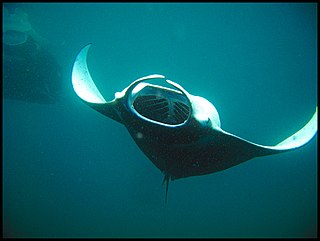
A planktivore is an aquatic organism that feeds on planktonic food, including zooplankton and phytoplankton. Planktivorous organisms encompass a range of some of the planet's smallest to largest multicellular animals in both the present day and in the past billion years; basking sharks and copepods are just two examples of giant and microscopic organisms that feed upon plankton.
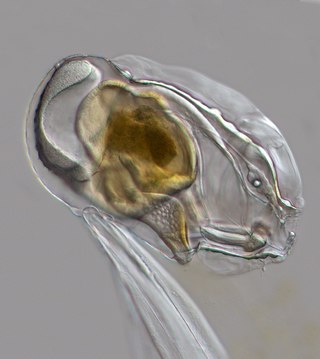
Oikopleura dioica is a species of small pelagic tunicate found in the surface waters of most of the world's oceans. It is used as a model organism in research into developmental biology.
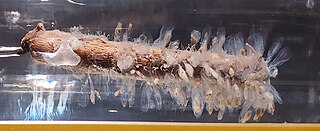
Perophora regina is a species of colonial sea squirt in the genus Perophora. It is native to the tropical western Atlantic Ocean where it is found growing on mangrove roots on the Belize Barrier Reef.
Dolioletta mirabilis is a species of tunicate in the family Doliolidae. It is small, exists in various forms and is sometimes found in great abundance in the Indo-Pacific waters where it lives.
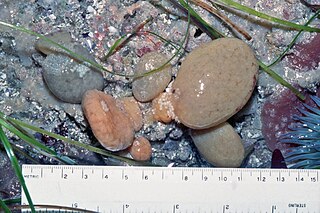
Polyclinum planum is a compound ascidian commonly known as the elephant ear tunicate. It is an ascidian tunicate in the family Polyclinidae. Ascidians are also known as sea squirts.
A gonozooid is any of the reproductive individuals of tunicate, bryozoan, or hydrozoan colonies that produce gametes. Gonozooids may play a role in labour division or in alternation of generations. A gonozooid typically has hardly any other function than reproduction, amounting to little more than a motile gonad.













